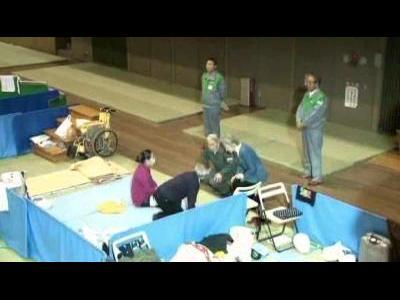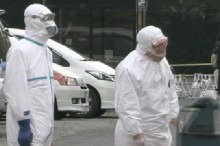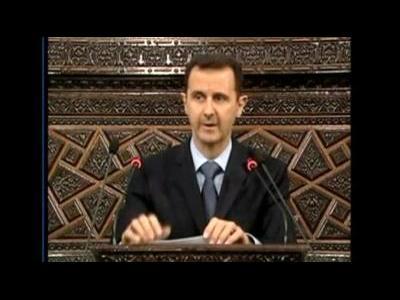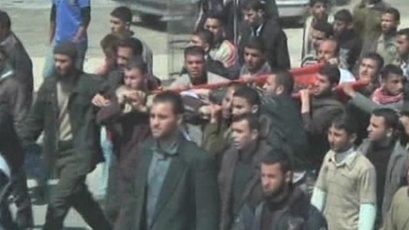 Reuters – A protester wearing protective suit and a gas mask poses during a protest in central Sofia March 30, …
Reuters – A protester wearing protective suit and a gas mask poses during a protest in central Sofia March 30, …VIENNA – Recent radiation readings outside the exclusion zone around Japan's nuclear disaster show radiation substantially higher than levels at which the U.N. nuclear agency would recommend evacuations, agency officials said.
The comments Wednesday could add to the debate over how far people need to stay away from Japan's Fukushima Dai-ichi nuclear complex, which was crippled in the country's March 11 earthquake and tsunami.
Elena Buglova, an official from the International Atomic Energy Agency, said of the reading: "As a ratio, it was about two times higher" than levels at which the agency recommends evacuations.
Iitate is about 25 miles (40 kilometers) from the Fukushima complex where emergency crews are battling to keep radioactivity from spreading.
Japanese officials have told residents to evacuate within a 12-mile (20-kilometer) zone and to stay indoors within 18 miles (30 kilometers) of the damaged complex, but U.S. officials have recommended citizens stay at least 50 miles (80 kilometers) away.
The officials emphasized that the readings at the village of Iitate were sporadic and only at one measuring point.
Denis Flory, a senior IAEA official, demurred when asked whether the agency was recommending that the village be cleared of residents but said it had advised Japanese authorities to "carefully assess the situation."
"The highest values were found in a relatively small area in the northwest from the Fukushima power plant and the first assessment indicates that one of the IAEA operational criteria for evacuation is exceeded in Iitate village," he told reporters.
Buglova also indicated the readings were preliminary saying "there is a range of uncertainty involved."
About 10 days ago, radiation in the village's tap water spiked, though they remained well below levels that would pose an immediate health risk. The latest reading came between March 18 and March 26, when a series of samples were taken from a wide area, according to a report on the agency's website. Both iodine-131 and cesium-137 were found in the samples.
Richard Morin, a medical physicist with the American College of Radiation, said the agency's evacuation limits are "intended to be extremely conservative," and that none of the levels found would pose a risk to human health. They all fell well below the radiation contained in a heart scan.
Separately, agency officials said Singapore authorities had measured radiation readings from cabbage imported from Japan that were up to nine times above international recommended safety levels — iodine 131 readings of up to 936 becquerels per kilogram.
Earlier, IAEA head Yukiya Amano told reporters that he had issued invitations to government ministers from the agency's 151 member nations to attend a June conference on safety procedures at nuclear plants worldwide in the wake of the Japan disaster.
Amano said the conference will focus on assessments of the Fukushima Dai-ichi disaster and lessons that need to be learned from it.
 Play Video Reuters – Japan's Emperor tours evacuation centre
Play Video Reuters – Japan's Emperor tours evacuation centre ___
Veronika Oleksyn contributed to this report.
http://news.yahoo.com/s/ap/20110331/ap_on_he_me/un_japan_nuclear











 "Ini merupakan nilai pelaburan yang tertinggi di Malaysia berbanding dengan negeri-negeri yang lain," kata Pengerusi Jawatankuasa Tetap Pelaburan, Perindustrian dan Perdagangan negeri, Teresa Kok Suh Sim.
"Ini merupakan nilai pelaburan yang tertinggi di Malaysia berbanding dengan negeri-negeri yang lain," kata Pengerusi Jawatankuasa Tetap Pelaburan, Perindustrian dan Perdagangan negeri, Teresa Kok Suh Sim.


 Mengulas lanjut mengenai tulisannya itu, pensyarah di Universiti Sains Malaysia (USM) itu berkata, beliau mendapat reaksi banyak pihak termasuk cadangan supaya beliau “mengepalai” perhimpunan anti-politik lucah itu.
Mengulas lanjut mengenai tulisannya itu, pensyarah di Universiti Sains Malaysia (USM) itu berkata, beliau mendapat reaksi banyak pihak termasuk cadangan supaya beliau “mengepalai” perhimpunan anti-politik lucah itu.

 "Interlok sepenuhnya menyeru kepada fahaman ketuanan Melayu. Pada pandangan kami, novel ini bukan sahaja tidak sihat (untuk bacaan pelajar) tetapi juga beracun," kata Naib Presiden Dewan Perhimpunan Cina Kuala Lumpur dan Selangor (KLSCAH) Cheng Su Chean.
"Interlok sepenuhnya menyeru kepada fahaman ketuanan Melayu. Pada pandangan kami, novel ini bukan sahaja tidak sihat (untuk bacaan pelajar) tetapi juga beracun," kata Naib Presiden Dewan Perhimpunan Cina Kuala Lumpur dan Selangor (KLSCAH) Cheng Su Chean. "Tetapi penyelesaiannya, Interlok tidak patut dijadikan buku teks di sekolah."
"Tetapi penyelesaiannya, Interlok tidak patut dijadikan buku teks di sekolah."
 Kalau diikut ungkapan Inggeris, soalan cepumas itu bernilai tujuh juta dolar, bermakna ia sukar dijawab. Namun apa yang pasti adalah dunia ini sentiasa penuh dengan mereka yang mempunyai wajah seiras.
Kalau diikut ungkapan Inggeris, soalan cepumas itu bernilai tujuh juta dolar, bermakna ia sukar dijawab. Namun apa yang pasti adalah dunia ini sentiasa penuh dengan mereka yang mempunyai wajah seiras. Semua ini menjurus kepada peringatan bahawa siasatan polis terhadap video lucah yang ditayangkan oleh 'Datuk T' harus memperinci kemungkinan pelakunya adalah seorang yang mirip wajah Anwar.
Semua ini menjurus kepada peringatan bahawa siasatan polis terhadap video lucah yang ditayangkan oleh 'Datuk T' harus memperinci kemungkinan pelakunya adalah seorang yang mirip wajah Anwar. Polis juga rasanya mahu mengetahui kenapa Tan Sri Rahim Thamby Chik, Datuk Shazyl Eskay dan Datuk Shuib Lazim menyembunyikan identiti mereka apabila mengatur majlis pra-tonton video ini pada minggu lalu di Hotel Carcosa Seri Negara.
Polis juga rasanya mahu mengetahui kenapa Tan Sri Rahim Thamby Chik, Datuk Shazyl Eskay dan Datuk Shuib Lazim menyembunyikan identiti mereka apabila mengatur majlis pra-tonton video ini pada minggu lalu di Hotel Carcosa Seri Negara.  Adalah tidak keterlaluan untuk mengatakan Eskay sendiri mempunyai iras wajah Anwar dari sudut tertentu.
Adalah tidak keterlaluan untuk mengatakan Eskay sendiri mempunyai iras wajah Anwar dari sudut tertentu.  Apapun terlalu banyak persoalan yang masih belum ditangani, contohnya mana pergi pelaku wanita dalam video itu dan kenapa mereka yang menonton video itu - ahli parlimen Sungai Petani Johari Abdul dan bekas MPP PKR BadrulHisham Shahrin tidak disoal polis. Begitu juga dengan Mahti (kiri).
Apapun terlalu banyak persoalan yang masih belum ditangani, contohnya mana pergi pelaku wanita dalam video itu dan kenapa mereka yang menonton video itu - ahli parlimen Sungai Petani Johari Abdul dan bekas MPP PKR BadrulHisham Shahrin tidak disoal polis. Begitu juga dengan Mahti (kiri). 

 "Tapi sampai sekarang belum ada apa-apa (permohonan maaf)," katanya lagi.
"Tapi sampai sekarang belum ada apa-apa (permohonan maaf)," katanya lagi. Anggota berkenaan juga didakwa telah menyerang dan membuat tangkapan salah ke atas beberapa orang yang ditahan dalam kejadian berkenaan, katanya.
Anggota berkenaan juga didakwa telah menyerang dan membuat tangkapan salah ke atas beberapa orang yang ditahan dalam kejadian berkenaan, katanya.
 Menurut Bernama, Anwar yang tiba di kedai makan itu pada jam 7.30 malam dan kemudiannya dimaklumkan oleh Ketua Polis Daerah Kuching, ACP Mun Kok Keong bahawa beliau tidak dibenarkan berceramah kerana tiada permit.
Menurut Bernama, Anwar yang tiba di kedai makan itu pada jam 7.30 malam dan kemudiannya dimaklumkan oleh Ketua Polis Daerah Kuching, ACP Mun Kok Keong bahawa beliau tidak dibenarkan berceramah kerana tiada permit. Mun dilaporkan merampas mikrofon apabila ADUN Kuala Sepetang yang juga bekas exco Perak Tai Sing Ng sedang berucap dan menuntut beliau menunjukkan kad pengenalannya.
Mun dilaporkan merampas mikrofon apabila ADUN Kuala Sepetang yang juga bekas exco Perak Tai Sing Ng sedang berucap dan menuntut beliau menunjukkan kad pengenalannya. Ng berjaya berucap dengan kebanyakan hadirin berpeluh kerana kepanasan kira-kira 20 minit sebelum Anwar tiba.
Ng berjaya berucap dengan kebanyakan hadirin berpeluh kerana kepanasan kira-kira 20 minit sebelum Anwar tiba. IPOH, 30 Mac: Mesyuarat Jawatankuasa Fatwa Negeri Perak yang bersidang pada 24-26 Januari 2011 lalu telah memperakukan supaya tarian atau senama poco-poco diharamkan.
IPOH, 30 Mac: Mesyuarat Jawatankuasa Fatwa Negeri Perak yang bersidang pada 24-26 Januari 2011 lalu telah memperakukan supaya tarian atau senama poco-poco diharamkan.
 "Saya pun sebagai Menteri di Jabatan Perdana Menteri tidak tahu tentang pemberian contract award ini.
"Saya pun sebagai Menteri di Jabatan Perdana Menteri tidak tahu tentang pemberian contract award ini. KUCHING, 30 Mac: Meskipun polis sedari dulu sentiasa memberi tekanan demi tekanan terhadap Datuk Seri Anwar Ibrahim, Ketua Umum PKR itu tegas menyatakan beliau mahu membawa perubahan politik secara aman dengan menggunakan saluran pilihan raya.
KUCHING, 30 Mac: Meskipun polis sedari dulu sentiasa memberi tekanan demi tekanan terhadap Datuk Seri Anwar Ibrahim, Ketua Umum PKR itu tegas menyatakan beliau mahu membawa perubahan politik secara aman dengan menggunakan saluran pilihan raya. Ceramah Anwar di mana-mana jua termasuk di Sarawak sentiasa mendapat halangan polis.
Ceramah Anwar di mana-mana jua termasuk di Sarawak sentiasa mendapat halangan polis.